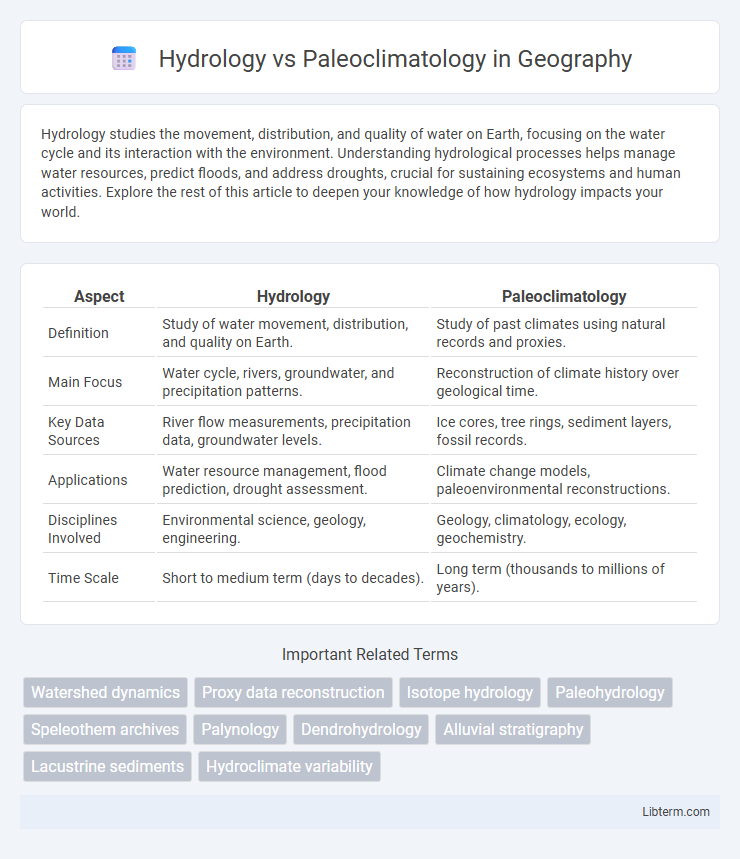Hydrology studies the movement, distribution, and quality of water on Earth, focusing on the water cycle and its interaction with the environment. Understanding hydrological processes helps manage water resources, predict floods, and address droughts, crucial for sustaining ecosystems and human activities. Explore the rest of this article to deepen your knowledge of how hydrology impacts your world.
Table of Comparison
| Aspect | Hydrology | Paleoclimatology |
|---|---|---|
| Definition | Study of water movement, distribution, and quality on Earth. | Study of past climates using natural records and proxies. |
| Main Focus | Water cycle, rivers, groundwater, and precipitation patterns. | Reconstruction of climate history over geological time. |
| Key Data Sources | River flow measurements, precipitation data, groundwater levels. | Ice cores, tree rings, sediment layers, fossil records. |
| Applications | Water resource management, flood prediction, drought assessment. | Climate change models, paleoenvironmental reconstructions. |
| Disciplines Involved | Environmental science, geology, engineering. | Geology, climatology, ecology, geochemistry. |
| Time Scale | Short to medium term (days to decades). | Long term (thousands to millions of years). |
Introduction to Hydrology and Paleoclimatology
Hydrology studies the distribution, movement, and quality of water on Earth, emphasizing processes such as precipitation, evaporation, and groundwater flow. Paleoclimatology examines past climate conditions by analyzing geological records like ice cores, tree rings, and sediment layers to understand long-term environmental changes. Both fields contribute critical insights into Earth's water cycle and climate history, informing modern environmental management and climate prediction models.
Core Concepts of Hydrology
Hydrology centers on the distribution, movement, and quality of water through Earth's systems, emphasizing processes like precipitation, infiltration, evaporation, and runoff. Key concepts include the hydrologic cycle, watershed dynamics, groundwater flow, and surface water interactions, which are critical for water resource management and environmental sustainability. Paleoclimatology, while studying historical climate patterns, often relies on hydrological data from sediment cores and isotopic analysis to reconstruct past water cycles and climate variability.
Foundations of Paleoclimatology
Paleoclimatology relies on sediment cores, ice cores, tree rings, and isotopic data to reconstruct past climate conditions, providing insights into Earth's climate history over geological timescales. Hydrology focuses on the distribution, movement, and quality of water in the present environment, emphasizing processes like precipitation, evaporation, and river flow. Foundations of paleoclimatology integrate proxy data and analytical techniques to interpret climatic variations, linking past hydrologic cycles with global climate dynamics.
Key Differences Between Hydrology and Paleoclimatology
Hydrology studies the movement, distribution, and quality of water on Earth, focusing on contemporary water cycles and resources, while paleoclimatology reconstructs past climate conditions using proxy data like ice cores, tree rings, and sediment records. Hydrologists analyze current water availability and management, relying heavily on hydrological models and real-time data, whereas paleoclimatologists interpret climatic trends over geological time scales to understand long-term environmental changes. The key difference lies in hydrology's emphasis on present and near-future water systems versus paleoclimatology's focus on historical climate patterns and their influence on Earth's ecosystems.
Methods and Tools in Hydrological Studies
Hydrological studies primarily utilize tools such as remote sensing, geographic information systems (GIS), and hydrological models like SWAT (Soil and Water Assessment Tool) to analyze water cycle components and predict water resource availability. Field instruments including flow meters, rain gauges, and groundwater monitoring wells are essential for collecting real-time data on precipitation, streamflow, and aquifer levels. Data assimilation techniques and statistical analysis enhance the accuracy of hydrological models, supporting effective water management and disaster mitigation strategies.
Techniques Used in Paleoclimatological Research
Paleoclimatological research employs techniques such as ice core analysis, dendrochronology, and sediment core sampling to reconstruct past climate conditions. Stable isotope analysis and radiometric dating are critical for determining the age and composition of climatic proxies. These methods provide essential data for understanding long-term climate variability beyond the observational period of hydrology.
Applications of Hydrology in Modern Science
Hydrology plays a crucial role in water resource management, flood prediction, and climate change impact assessments by analyzing the distribution and movement of water in the environment. Modern applications utilize remote sensing, geographic information systems (GIS), and hydrological modeling to improve agricultural planning, urban development, and disaster mitigation. In contrast to paleoclimatology, which reconstructs past climate conditions using proxy data, hydrology provides real-time data essential for sustainable water management and environmental protection.
Significance of Paleoclimatology in Climate Reconstruction
Paleoclimatology plays a crucial role in climate reconstruction by analyzing proxy data such as ice cores, tree rings, and sediment layers to understand past climate variations over thousands to millions of years. This long-term perspective provides context for current hydrological patterns and helps predict future water resource trends under changing climate conditions. Hydrology benefits from paleoclimatic insights by improving models of precipitation, runoff, and water cycle dynamics influenced by historical climate shifts.
Interdisciplinary Connections: Hydrology Meets Paleoclimatology
Hydrology and paleoclimatology intersect through the study of past water cycles and climate variations using sediment cores, isotopic analysis, and tree-ring data. This interdisciplinary approach enhances understanding of historical precipitation patterns, flood events, and drought frequencies, providing critical insights for predicting future hydrological responses to climate change. Integrating hydrological models with paleoclimate reconstructions improves water resource management and risk assessment in changing environmental conditions.
Future Trends in Hydrology and Paleoclimatology
Future trends in hydrology emphasize the integration of advanced remote sensing technologies and machine learning algorithms to enhance water resource management and predict hydrological extremes under climate change scenarios. Paleoclimatology is increasingly leveraging high-resolution sediment cores and isotopic analyses to reconstruct past climate variability, improving the understanding of long-term climate patterns and informing future climate models. Both fields prioritize interdisciplinary approaches combining data science, geospatial analysis, and environmental monitoring to address global challenges such as droughts, floods, and climate resilience.
Hydrology Infographic

 libterm.com
libterm.com